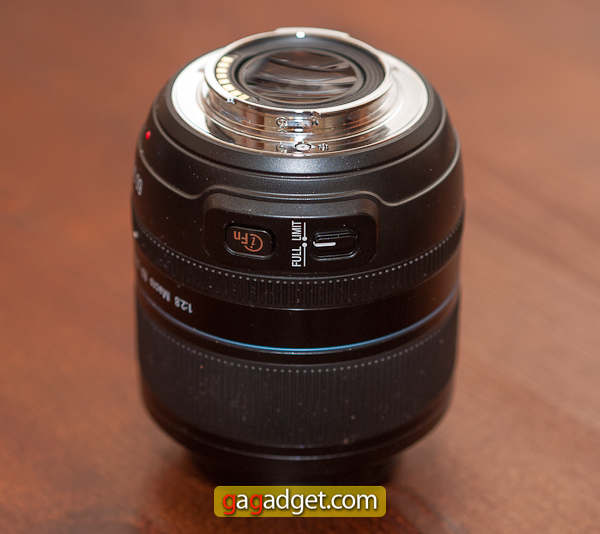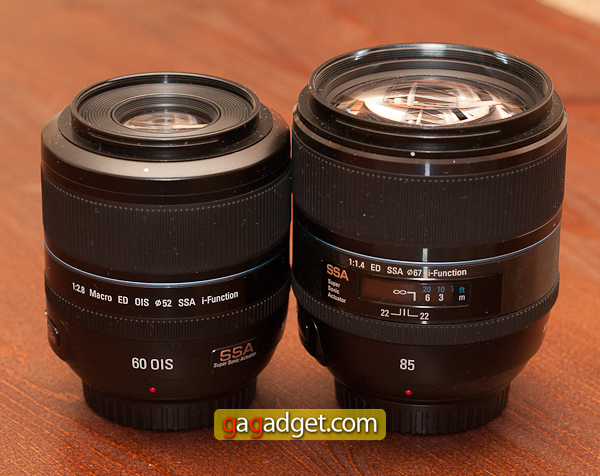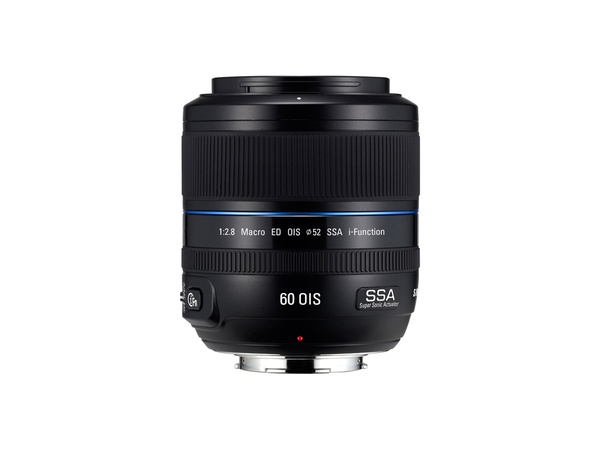Samsung NX 60mm f/2.8 ED OIS SSA macro lens review
Samsung NX 60mm f/2.8 ED OIS SSA macro lens review
The macro lens for Samsung NX series mirrorless cameras called 60mm f/2.8 ED OIS SSA is a premium device and is on par with the Samsung 85mm f/1.4 model. The new optics are equipped with a ring ultrasonic motor for focusing and image stabilization. Regardless of its purpose, the lens can provide an angle of view as well as depth of field that is similar to a 90mm f/4.0 lens on a full-frame camera.
NX 60mm f/2.8 ED OIS SSA Lens Specifications
- Lens type: fixed focal length optics.
- Mount: NX (Samsung).
- Focal length: 60 mm.
- Aperture: f/2.8.
- Minimum aperture: f/22.
- Shape and number of aperture blades: rounded, 7 pcs.
- Optical formula: 9 groups, 12 elements. Including one aspherical and one ultra-low dispersion lens.
- Focusing motor: SSA, SuperSonic Actuator (ultrasonic).
- Focal length scale: no.
- Manual focus adjustment: yes.
- Minimum focusing distance: 0.19 m.
- Maximum scale: 1x.
- Thread for filters: 52 mm.
- Dimensions and weight: length - 84 mm; diameter - 74 mm; weight - 389 grams.
The Samsung NX 60mm f/2.8 lens has a very complex optical formula, which includes 9 groups with 12 lenses. It also includes aspherical and ultra-low-disperse elements. The lens uses a floating element design, which allows for optimal resolution when focusing at infinity and on MDF.
Appearance and design
The Samsung NX 60mm f/2.8 has good build quality. The device body is made of durable, high-quality plastic. The mount and some decorative elements are made of metal. The focusing ring and i-Function are rubberized and have a pleasant, smooth operation.
The disadvantage of the lens is the lack of switches for optical stabilization and manual/automatic focus. However, there is a focus range switch with two modes. Limit mode allows the lens to focus in ranges ranging from 50 cm to infinity. Full mode allows you to focus in the range from 19 cm to infinity.
The dimensions of the NX 60/2.8 are practically no different from the NX 85/1.4. The device weighs only 389 grams, which is slightly less than the NX 85/1.4. The Samsung NX200 camera with a 60/2.8 lens will not nod off, so this combination of devices can be called ideal. In addition, the optical stabilizer greatly facilitates handheld shooting when zooming.
Autofocus
The ultrasonic autofocus motor operates silently. In Limit mode, focusing is very fast. This mode can be left enabled by default. The implementation of the mode switch is not very successful. It would be more convenient to be able to switch in more than two ranges. This functionality is implemented in Canon lenses. They make it possible to work in the range from MDF to 50 cm, from 50 cm to infinity and in full mode.
Just like the NX 85/1.4, the NX 60/2.8 lens has the ability to focus manually, without switching to manual focus mode.
Image quality and test photos
The Samsung NX 60mm f/2.8 Macro demonstrates enviable image quality. Like every decent lens, our hero is sharp even with an open aperture, although this is not very important for macro photography itself. The maximum open aperture allows you to take pictures with a very pleasant pattern, which makes the optics suitable for creating portraits. Bokeh has a soft and pleasant watercolor texture.
Contrary to expectations, chromatic aberrations were not detected, but there was a purple fringe in areas of maximum contrast, however, this is most likely a defect of the matrix, not the lens.
conclusions
In order not to talk for a long time about the pros and cons, let’s formulate everything briefly and clearly. The Samsung NX 60mm f/2.8 Macro ED OIS SSA is a very good lens for mirrorless cameras. It can be placed on a par with the long-proven 30mm f/2 optics. The device is lightweight, which has a positive effect on the convenience of shooting. A nice feature is the fast and silent autofocus and, of course, excellent image quality. The device costs $563, which is not a high price for a lens of this class. Overall, the lens is good and can be safely recommended for use.
Positive features of Samsung NX 60/2.8 ED OIS SSA:
- very good image quality;
- soft and pleasant background blur;
- silent autofocus with FTM support;
- Excellent build quality and durable materials.
Negative feature of Samsung NX 60/2.8 ED OIS SSA:
- not the most successful implementation of the focus range switch.
Samsung 60mm f/2.8 Macro ED OIS SSA

- Lens type: macro lens
- Bayonet: Samsung NX
- For partial frame cameras: No
- 3D support: No
- Adapted for video recording: No
- Min. aperture: F22
- Min. Focusing distance: 0.19 m
- Focal length: fixed
- Focusing motor (for Nikon F): Yes
- Ultrasonic motor: Yes
Buy
Here you can watch a video review of the Samsung 60mm f/2.8 Macro ED OIS SSA. Find out the characteristics, read reviews about the Samsung 60mm f/2.8 Macro ED OIS SSA.
Stores where you can buy this product and its analogues
Video reviews of Samsung 60mm f/2.8 Macro ED OIS SSA
- All 8
- Reviews 1
- Unboxing 1
- Setting 1
- Tests 6
- Reviews 5
 SAM_0340.MP4
SAM_0340.MP4
Specifications of Samsung 60mm f/2.8 Macro ED OIS SSA
* Check with the seller for exact specifications.
Main characteristics
| Lens type | macro lens |
| Bayonet | Samsung NX |
| For full-frame cameras | No |
| 3D support | No |
| Adapted for video shooting | No |
Shooting options
| Min. diaphragm | F22 |
| Min. focusing distance | 0.19 m |
| Focal length | permanent |
| Focusing motor (for Nikon F) | Eat |
| Ultrasonic motor | Eat |
| Image stabilization | Eat |
| Auto Focus | Eat |
| Internal focusing | Eat |
Zoom Lens Focal Length
| Minimum | 60 mm |
Diaphragm
| At maximum focal length | F2.8 |
| At minimum focal length | F2.8 |
Viewing angle
| Minimum | 26.4 degrees |
Macro photography
| Macro mode | No |
Design
| Number of elements | 12 |
| Number of aperture blades | 7 |
| Number of aspherical elements | 1 |
| Number of element groups | 9 |
| Number of low-disperse elements | 1 |
Additional Information
| Thread diameter for filter | 52 mm |
| Weight | 389 g |
| Tilt/Shift function | No |
| Length | 84 mm |
| Diameter | 74 mm |
* Check with the seller for exact specifications.
Pros and cons of Samsung 60mm f/2.8 Macro ED OIS SSA
Reviews of Samsung 60mm f/2.8 Macro ED OIS SSA
Thank you, your review will appear on the site soon.
A quick review of the Samsung NX 60mm f/2.8 Macro ED OIS SSA lens

The Samsung NX 60mm f/2.8 ED OIS SSA macro lens, along with the Samsung 85mm f/1.4 lens we have already reviewed, is part of the premium optics line for Samsung NX mirrorless cameras. It boasts excellent equipment (ring-shaped ultrasonic focusing motor, image stabilizer) and, all other things being equal, provides an angle of view and depth of field similar to a lens with a focal length of 90mm and f/4.0 aperture on a full-frame camera.
Specifications Samsung NX 60mm f/2.8 ED OIS SSA
- Type: fixed focal length lens.
- Bayonet: Samsung NX.
- Focal length: 60 mm.
- Aperture: f/2.8.
- Minimum aperture: f/22.
- Number and shape of aperture blades: 7, rounded.
- Optical formula: 12 elements in 9 groups, including one aspherical and one ultra-low dispersion lens.
- Focusing motor: ultrasonic (SSA, SuperSonic Actuator).
- Focus scale: no.
- Possibility of manual focus adjustment: yes.
- Minimum focusing distance: 0.19 m.
- Maximum scale: 1x.
- Thread for filters: ⌀52 mm.
- Dimensions and weight: 84 mm (length) x 74 mm (diameter), 389 grams.
The Samsung NX 60mm f/2.8 lens has a very complex optical formula, including as many as 12 lenses in 9 groups, including one aspherical and one ultra-low dispersion element. In this case, the lens uses a floating element design to achieve optimal resolution when focusing at both infinity and MDF.
Appearance and design
The Samsung NX 60mm f/2.8 has good build quality. The lens body is made of high-quality plastic, the mount is metal, and so is the decorative ring with inscriptions. The focus rings and i-Function are rubberized and smooth.

The lens, unfortunately, is not equipped with either an optical image stabilizer switch or a manual/automatic focus switch. At the same time, it has a focusing range switch. In Limit mode, the lens focuses in the range from 50 cm to infinity, in Full mode - in the range from 19 cm to infinity.

In terms of dimensions, the NX 60/2.8 is not much different from the NX 85/1.4, but it weighs much less - only 389 grams. As a result, the combination of the Samsung NX200 and 60/2.8 camera does not bog down, so in general it can be called quite ergonomic. The optical image stabilizer makes it much easier to frame when shooting handheld.
Autofocus
The lens is equipped with a ring ultrasonic focusing motor. Focusing is completely silent. Autofocus speed in Limit mode is very good, so we can recommend keeping the switch in this mode by default, switching to the full focusing range only when shooting macro. In general, the implementation of the switch can be called completely stupid: it would be much more convenient to switch across several ranges (for example, from MDF to half a meter, from half a meter to infinity and full), as is implemented in Canon macro lenses. Like the NX 85/1.4, the NX 60/2.8 supports manual focus adjustment without switching to manual focus mode (FTM, Full-Time Manual).
Image quality and test image gallery
The Samsung NX 60mm f/2.8 Macro demonstrated excellent image quality. As befits a macro lens, it is sharp starting from an open aperture, although this does not matter directly during macro photography (since you have to clamp the aperture to f/8-f/16 to obtain an acceptable depth of field). At the same time, at the maximum open aperture, the lens has a very pleasant pattern and is completely devoid of the “dermatological” characteristic of macro lenses, which makes it a good choice for shooting portraits. It is worth noting the very soft, “watercolor” nature of the background blur. Under certain conditions, bokeh takes on a characteristic “swirled” appearance. I was not able to detect “classic” chromatic aberrations in the photographs, but purple fringes do exist in places of maximum contrast (although the matrix is more to blame for this than the lens). As usual, full-size examples of photographs can be found in a separate gallery.

Artificial intelligence in TVs: how it works
Bottom line
I won’t prevaricate and beat around the bush: in my opinion, the Samsung NX 60mm f/2.8 Macro ED OIS SSA is one of the most successful lenses in the system, along with the well-proven “pancake” 30mm f/2. It has acceptable weight and size characteristics, fast and silent autofocus and excellent image quality. At the same time, the cost of the lens (about 4,500 hryvnia) can be called low compared to the prices for similar optics for other systems. Overall, the lens deserves an absolute recommendation.
4 reasons to buy Samsung NX 60/2.8 ED OIS SSA:
- excellent image quality;
- nice nature of background blur;
- silent autofocus with FTM support;
- good materials and build quality.
1 reason not to buy Samsung NX 60/2.8 ED OIS SSA:
- poor implementation of the focus range limiter.

Pay attention to our other reviews of digital cameras, there is plenty to choose from.
Subscribe to our fun channel on Telegram so you don't miss anything.
Notes malykh.com
2014-04-28
Samsung NX 60mm f/2.8 Macro ED OIS SSA: my impressions
I was able to try the Samsung NX 60/2.8 lens, I’ll tell you my impressions.
The lens can seem quite bulky. Looks large on the NX300:

But such dimensions are not surprising, because this is a macro lens with its own requirements.
Optically it is quite good. Minimal distortion (in cameras you can’t even turn on automatic correction). Without reservations, working on an open aperture. Slight chromatic aberration. But on this particular specimen, under certain conditions, there is some strange blurring of the upper right corner. Either it was defective or dropped.
Focusing is internal, which is convenient at short distances (the long “trunk” does not creep out). Autofocus is slow. There is a focusing distance limiter (so that during normal shooting you don’t waste time focusing close), but autofocus still can’t be called fast. Manual focusing is atypical for Samsung NX lenses: the focus ring mechanically moves the internal parts, manually starts to idle when going beyond the limits and stands still when autofocus is working. Very similar to Pentax Quick-Shift. You need to switch to fully manual focusing mode on the camera.
The NX 60/2.8 has a second ring purely for iFN; it cannot focus.
On the camera screen with this lens you can see the focusing distance and magnification (zoom) scale. But its implementation depends on the camera. For example, on the NX20 it is part of the custom shooting view, and you can select the units of measurement.

And on the NX300, the scale is part of the main view when shooting, the units are not adjustable:

This confirms the feeling that Samsung camera interfaces are made by different people every time.
This lens has an optical stabilizer. But I didn't really like it. It works somehow roughly, it makes a lot of noise. The result is “floating”. Either excellent, or blurry even at fairly short shutter speeds. On a tripod at long shutter speeds there is a regular smear, you need to turn off the stabilizer (by the way, this is very inconvenient to do on Samsung NX cameras; you have to crawl through the main menu). At 18-55 and 50-200 the stabilizer works, in my opinion, better.
Now about macro opportunities. Claimed increase x1. The matrix size is 23.5 x 15.7 mm, which means that the width at the minimum focusing distance should fit no more than 23.5 mm.

This is approximately the case, which means the declared increase is achieved.
I tried this lens with FOTGA rings. With two rings (10+16 = 26 mm) it was possible to achieve the following increase:

Those. magnification approximately x1.6. The lens on the rings works well (even autofocus somehow survives).
Naturally, photographing at such magnifications requires skill and preparation. The depth of field is very small, there is not enough light. It’s more convenient to focus by moving the camera, turning the aperture harder, and highlighting the subject with a flash or flashlights.
Overall, apart from the oddity with the “soap” in the corner, the lens is a very good tool for macro photography. But for normal use it seems somehow redundant and insufficient. Too big, too dark. My NX 45/1.8 is optically weaker (more distortion, I think it will lose in terms of resolution, macro photography is much weaker), but it seems more soulful to me. 🙂
But, I repeat, the NX 60/2.8 is a tool and must be approached with appropriate judgment. For example, for extremely rare macro photography, I use the old Pentax M 100/4 (this can be considered a full-frame analogue of 60/2.8, but it only gives x0.5 magnification). So its dimensions are comparable to the NX 60/2.8:
Samsung 60mm f/2.8 Macro ED OIS SSA
Key Features. Studio test
The Samsung 60mm f/2.8 Macro ED OIS SSA was the first macro lens in the NX system. The appearance of specialized lenses in the system on a par with already produced budget models and compact pancake primes so beloved by photographers is a serious step on the part of the company. Considering that Samsung also announced a fast 85mm portrait lens, it's clear that Samsung has high hopes for the mirrorless camera market.

Main features of the model:
- maximum shooting scale 1:1;
- built-in image stabilizer;
- silent high-speed autofocus drive;
- metal case.
Despite the fact that the NX system was originally designed to work with APS-C cameras, and the average size of Samsung NX lenses is significantly smaller than their full-frame counterparts, the Samsung 60mm f/2.8 Macro ED OIS SSA turned out to be simply huge, and in addition heavy. Apparently, a complex optical design with an image stabilizer imposed some limitations. In general, this is perhaps the first 60mm macro lens with stabilization in the history of photographic equipment.
The body is made of metal. The assembly did not cause any complaints. The lens is almost monolithic. During focusing, the external dimensions do not change. The front lens, of course, also does not rotate, which allows you to use polarizing filters without any problems. On the body there are autofocus and stabilizer switches, as well as a button for the proprietary i-Function interface.
But there is no focusing distance limiter. So every time you focus, the lens will travel almost the full distance: from infinity or from the minimum focusing distance to the desired point. And because of this, when shooting ordinary everyday scenes, the autofocus speed may disappoint you somewhat. It is important to understand that the Samsung 60mm f/2.8 Macro ED OIS SSA is a highly specialized macro lens.
However, in the Samsung NX200 the focus distance limiter will be implemented in the camera menu. It is possible that in subsequent cameras Samsung will adhere to a similar implementation of this function.
However, autofocus is rarely used in macro photography. Anyone who works a lot in this genre is very familiar with this feature. It is much easier to control focus by moving the camera itself. But despite this, the Samsung 60mm f/2.8 Macro ED OIS SSA makes it easy to focus manually: the focusing ring is wide and grippy. It controls the movement of the lenses directly, rather than through servos, which makes using this lens very convenient. The only difficulty with manual focusing is related to the way the camera itself works (we used a Samsung NX11): with manual focusing, you can only zoom in on the central part of the frame. You cannot move the enlarged area to the side. You have to either always place the subject in the center, or reframe the future shot after focusing, risking losing sharpness at the desired point.
Image quality
At an open aperture, the lens demonstrates sufficient detail for 14 megapixels. But nevertheless, it is noticeable that the sharpness of the image is somewhat reduced. The distribution of sharpness across the frame is almost uniform. Contrast is high and chromatic aberrations are not visible.
When you stop down a stop, sharpness increases slightly. But the lens begins to show truly high detail starting at f/5.6. After f/11, a smooth decrease in sharpness begins due to diffraction. But f/16 is still a working aperture. At f/22, sharpness decreases slightly. But in extreme cases, this value can be applied in practice. But with an aperture value of f/32, diffraction already affects the detail of the image too much.
At an open aperture, the lens provides perfectly smooth round highlights in the out-of-focus area. The highlights have a faint edging. This may cause some ghosting in the bokeh area and make the drawing a little harsher. But we still did not notice such a problem on most test plots. Weak chromatic aberrations are noticeable at the edges of the frame.
When aperture is down to f/4, the nature of the pattern does not change, only the highlights become less round: barely noticeable corners appear in the shape of the aperture. At f/5.6, the rounded shape of the highlights remains, although the imperfection of the aperture shape becomes more and more noticeable. At f/8 the highlights finally become heptagonal.
The lens holds backlight perfectly without introducing stray flare into the frame. The characteristic rays around contrasting light sources in the frame become noticeable only after f/16.
conclusions
The formal disadvantages of this model include some softness of the image at an open aperture. That's all: this is where the cons end. If we talk about the Samsung 60mm f/2.8 Macro ED OIS SSA specifically as a macro lens, then we have a solid and high-quality photographic instrument. Even at small apertures (and macro photography still typically uses values between f/8 and f/22), the Samsung 60mm f/2.8 Macro ED OIS SSA provides excellent sharpness and beautiful background blur. Neither the build quality nor the ease of use of this lens caused any complaints. The Samsung 60mm f/2.8 Macro ED OIS SSA is pleasant to even hold in your hands, let alone shoot with it. Well, don’t forget that this is a status model in the Samsung optics line: the first specialized lens of the system, which clearly indicates the developers’ serious plans for Samsung NX cameras.
Samsung NX 60mm F2.8 Macro ED OIS SSA review: specs and price
Why is Samsung NX 60mm F2.8 Macro ED OIS SSA better than others?
- Widest aperture at maximum focal length
What are the most popular comparisons?
Fujifilm GF 32-64mm f/4 R LM WR
Fujifilm GF 63mm f/2.8 R WR
Leica Super-Vario-Elmar-TL 11-23mm f/3.5-4.5 ASPH
Sony FE 16-35mm f/2.8 GM
general information
Samsung NX-M 9mm F3.5 ED
A metal mount is generally better than a plastic mount because it is more durable.
Samsung NX 60mm F2.8 Macro ED OIS SSA
A fixed lens has a fixed focal length. They are usually sharper and have a wider aperture.
Samsung NX 60mm F2.8 Macro ED OIS SSA
A macro lens is used to take very close-up shots, allowing you to photograph insects, flowers, etc. in great detail. A macro lens is any lens with 1:1 magnification.
Samsung NX 60mm F2.8 Macro ED OIS SSA
It comes with a lens hood so you don't have to buy it separately. They are used to block strong light sources such as the sun to prevent glare.
Samsung NX 60mm F2.8 Macro ED OIS SSA
In short, the minimum focal length allows you to capture more of the scene in a photo, and offers a wider viewing angle than longer focal lengths.
Olympus M.Zuiko ED 14-42mm F3.5-5.6 EZ
Optics
Optical image stabilization uses gyroscopic sensors to monitor camera vibrations. The lens adjusts the optical path accordingly, preventing blurring of the image before it is captured.
Samsung NX 60mm F2.8 Macro ED OIS SSA
At the short end of the lens you get the widest angle of view. This allows you to fit more of the scene into a photo (based on the APS-C format).
Samyang 8mm F/2.8 UMC Fish-eye
At the long end of the lens you get the narrowest angle of view. This allows you to fit a small portion of the scene into a photo as if you were pointing the camera at the subject (based on the APS-C format).
Olympus M.Zuiko ED 75-300mm F4.8-6.7 II
A true macro lens has a 1:1 magnification. This means that the image is obtained as a life-size representation of the subject who was photographed.
Leica Vario-Elmarit-SL 24-90mm F2.8-4 ASPH
The zoom range is the ratio between the longest and shortest focal length. A higher zoom range means the lens is more versatile.
Samsung NX 18-200mm F3.5-6.3 ED OIS
Aperture
This is the widest aperture (diaphragm) available at the maximum focal length. With a wider aperture, the sensor can capture more light, helping to avoid blur through faster shutter speeds. It also provides a shallow depth of field, allowing you to blur the background to focus on your subject.
Leica Summilux-TL 35 mm f/1.4 ASPH
This is the widest aperture available at the shortest focal length. With a wider aperture, the sensor can capture more light, helping to avoid blur with a faster shutter speed. It also provides a shallow depth of field, allowing you to blur the background to focus on your subject.
Leica Summilux-TL 35 mm f/1.4 ASPH
This is the smallest aperture (aperture) available at the maximum focal length. A smaller aperture reduces the amount of light entering the sensor. This is important in bright lighting conditions, where a wide aperture can cause your photo to be overexposed (overexposed). Another benefit is that with a smaller aperture you get greater depth of field and can keep all your images in focus.
Search for lenses



